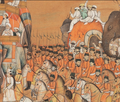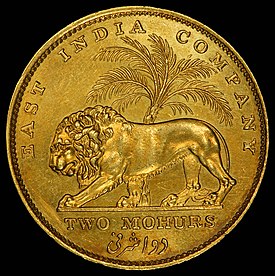| This article needs additional citations for verification. Please help improve this article by adding citations to reliable sources. Unsourced material may be challenged and removed. Find sources: "Akbar II" – news · newspapers · books · scholar · JSTOR (May 2017) (Learn how and when to remove this message) |
| Akbar II | |||||||||||||
|---|---|---|---|---|---|---|---|---|---|---|---|---|---|
| King of Delhi Badshah Shahanshah-e-Hind | |||||||||||||
 Portrait of Akbar Shah II, c. 1827 Portrait of Akbar Shah II, c. 1827 | |||||||||||||
| Emperor of Hindustan | |||||||||||||
| Reign | 19 November 1806 – 28 September 1837 | ||||||||||||
| Coronation | 19 November 1806 | ||||||||||||
| Predecessor | Shah Alam II | ||||||||||||
| Successor | Bahadur Shah II | ||||||||||||
| Born | Mirza Akbar (1760-04-22)22 April 1760 Mukundpur, Rewa State, Maratha Confederacy | ||||||||||||
| Died | 28 September 1837(1837-09-28) (aged 77) Delhi, Mughal Empire | ||||||||||||
| Burial | Moti Masjid, Delhi, India | ||||||||||||
| Spouse | Mumtaz Mahal Anwar Mahal Lal Bai | ||||||||||||
| Issue | 14 sons including
Mirza Firuz Bakht 8 daughters | ||||||||||||
| |||||||||||||
| House | House of Babur | ||||||||||||
| Dynasty | Timurid dynasty | ||||||||||||
| Father | Shah Alam II | ||||||||||||
| Mother | Qudsia Begum | ||||||||||||
| Religion | Sunni Islam (Hanafi) | ||||||||||||
| Seal |  | ||||||||||||
| Mughal emperors | ||||||||||||||||||||||||||||||||||||||||||||||
|---|---|---|---|---|---|---|---|---|---|---|---|---|---|---|---|---|---|---|---|---|---|---|---|---|---|---|---|---|---|---|---|---|---|---|---|---|---|---|---|---|---|---|---|---|---|---|
|
||||||||||||||||||||||||||||||||||||||||||||||
Akbar II (Persian pronunciation: [ak.baɾ]; 22 April 1760 – 28 September 1837), also known as Akbar Shah II, was the nineteenth Mughal emperor from 1806 to 1837. He was the second son of Shah Alam II and the father of Bahadur Shah II, who would eventually succeed him and become the last Mughal emperor.
Akbar had little de facto power due to the increasing British influence in India through the East India Company. He sent Ram Mohan Roy as an ambassador to Britain and gave him the title of Raja. During his regime, in 1835, the East India Company discontinued calling itself subject of the Mughal Emperor and issuing coins in his name. The Persian lines in the company's coins to this effect were deleted.
Akbar II was credited with starting the Hindu–Muslim unity festival Phool Walon Ki Sair. His grave lies next to the dargah of 13th-century Sufi saint Qutbuddin Bakhtiar Kaki at Mehrauli.
Early life

Prince Mirza Akbar was born on 22 April 1760 to Emperor Shah Alam II at Mukundpur, Satna, while his father was in exile. On 2 May 1781, at the Red Fort, the prince was made Crown prince with the title of Wali Ahd Bahadur, after the death of his elder brother. In 1782, he was appointed the viceroy of Delhi until 1799. When the Rohilla leader Ghulam Qadir captured Delhi in 1788, the young Prince Mirza Akbar was forced to nautch dance along with other Mughal princes. He witnessed how the members of the imperial Mughal family were humiliated, as well as starved. When Shah Jahan IV fled, Mirza Akbar was titular Emperor with the title of Akbar Shah II, and was to remain acting emperor even after the reinstatement of his father Shah Alam II, till January 1789.
Reign




Emperor Akbar II presided over an empire titularly large but in effect limited to the Red Fort in Delhi alone. The cultural life of Delhi as a whole flourished during his reign. However, his attitude towards East India Company officials, especially Lord Hastings, to whom he refused to grant an audience on terms other than those of subject and sovereign, although honourable to him, increasingly frustrated the British, who regarded him as merely their pensioner. The British therefore reduced his titular authority to 'King of Delhi' in 1835 and the East India Company ceased to act as the mere lieutenants of the Mughal Empire as they did from 1803 to 1835. Simultaneously they replaced Persian text with English text on the company's coins, which no longer carried the emperor's name.
The British encouraged the Nawab of Oudh and the Nizam of Hyderabad to take royal titles to further diminish the Emperor's status and influence. Out of deference, the Nizam did not, but the Nawab of Awadh did so.
He is also known to have bestowed the title Nawab upon the Nawab of Tonk and Nawab of Jaora.
Akbar II appointed the Bengali reformer Ram Mohan Roy, to appeal against his treatment by the East India Company, conferring on him the title of Raja. Ram Mohan Roy then visited England, as the Mughal envoy to the Court of St. James. Ram Mohan Roy submitted a well-argued memorial on behalf of the Mughal ruler, but to no avail.
The grave of Akbar II lies within a marble enclosure adjoined to the Moti Masjid near the dargah of the 13th century Sufi saint, Qutbuddin Bakhtiar Kaki at Mehrauli, Delhi. The Mughal emperors Bahadur Shah I, (Shah Alam I) and Shah Alam II are also buried here.
-
 Akbar II holding audience on the Peacock Throne.
Akbar II holding audience on the Peacock Throne.
-
 Silver Rupee coin of Akbar II.
Silver Rupee coin of Akbar II.
-
 Akbar Shah II rides an elephant in a huge procession 1835
Akbar Shah II rides an elephant in a huge procession 1835
-
 Akbar Shah II and his four sons
Akbar Shah II and his four sons
-
Durbar Procession of Mughal Emperor Akbar II, with British Resident Charles Metcalfe, by Udey Ram
-
 Cavalry in Durbar Procession of Mughal Emperor Akbar II
Cavalry in Durbar Procession of Mughal Emperor Akbar II
-
 Mounted standard-bearers in the procession of Akbar II
Mounted standard-bearers in the procession of Akbar II
Descendants

After the mutiny, cousins of Mirza Mughal, son of Bahadur Shah Zafar, son of Akbar II, escaped to neighbouring areas in fear of capture by the British. Prince Mirza Mughal, the heir apparent was himself captured and executed by the British near Delhi gate. Many surviving princes settled in various provinces of India, but some settled in Burma, Bengal and Deccan since a large number of imperial family members, along with Emperor Bahadur Shah II were exiled to Rangoon in Burma.
See also
References
- Jatindra Kumar Majumdar, ed. (1939). Raja Rammohun Roy and the Last Moghuls: A Selection from Official Records, 1803–1859. Art Press. pp. xxxiii. ISBN 9788170410645.
- Indian History Congress (1958). Proceedings, Volume 20. Indian History Congress. p. 316.
- Syed Mahdi Husain (2006). Bahadur Shah Zafar and the War of 1857 in Delhi. Aakar Books. p. 36. ISBN 9788187879916.
- "GREAT ESCAPE OF MIRZA JAHAN KHUSRO SON OF AKBAR SANI – HAJI MUHAMMED ISHAQUE DESCENDANT OF GREAT MUGHALS". 15 April 2020.
- Dec 8, TNN / (8 December 2012). "Akbar, Dara Shikoh had set examples of Hindu-Muslim unity | Varanasi News – Times of India". The Times of India.
{{cite news}}: CS1 maint: numeric names: authors list (link) - "Akbar and his religious policy" (PDF).
- Dadlani, Chanchal B. (2018). From stone to paper : architecture as history in the late Mughal Empire. New Haven . p. 63. ISBN 978-0-300-23317-9. OCLC 1024165136.
{{cite book}}: CS1 maint: location missing publisher (link)
Bibliography
- Whitehead, Richard Bertram (1929). "Akbar II as Pretender: A Study in Anarchy". Journal of the Royal Asiatic Society of Great Britain and Ireland. 61 (2): 259–272. doi:10.1017/S0035869X00082149. ISSN 0035-869X. JSTOR 25193883. S2CID 163201364.
[REDACTED] Media related to Akbar II at Wikimedia Commons
| Akbar II Timurid dynastyBorn: 1760 Died: 1837 | ||
| Regnal titles | ||
|---|---|---|
| Preceded byShah Alam II | Mughal Emperor 1806–1837 |
Succeeded byBahadur Shah II |
| Emperors | |||||||||
|---|---|---|---|---|---|---|---|---|---|
| Administration |
| ||||||||
| Conflicts |
| ||||||||
| Architecture |
| ||||||||
| See also | |||||||||
| Successor states | |||||||||